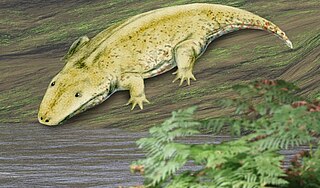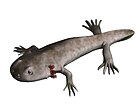
The Lissamphibia is a group of tetrapods that includes all modern amphibians. Lissamphibians consist of three living groups: the Salientia, the Caudata, and the Gymnophiona. A fourth group, the Allocaudata, was moderately successful, spanning 160 million years from the Middle Jurassic to the Early Pleistocene, but became extinct two million years ago.

The Batrachia are a clade of amphibians that includes frogs and salamanders, but not caecilians nor the extinct allocaudates. The name Batrachia was first used by French zoologist Pierre André Latreille in 1800 to refer to frogs, but has more recently been defined in a phylogenetic sense as a node-based taxon that includes the last common ancestor of frogs and salamanders and all of its descendants. The idea that frogs and salamanders are more closely related to each other than either is to caecilians is strongly supported by morphological and molecular evidence, they are for instance the only vertebrates able to raise and lower their eyes, but an alternative hypothesis exists in which salamanders and caecilians are each other's closest relatives as part of a clade called the Procera, with frogs positioned as the sister taxon of this group.

Lepospondyli is a diverse taxon of early tetrapods. With the exception of one late-surviving lepospondyl from the Late Permian of Morocco, lepospondyls lived from the Early Carboniferous (Mississippian) to the Early Permian and were geographically restricted to what is now Europe and North America. Five major groups of lepospondyls are known: Adelospondyli; Aïstopoda; Lysorophia; Microsauria; and Nectridea. Lepospondyls have a diverse range of body forms and include species with newt-like, eel- or snake-like, and lizard-like forms. Various species were aquatic, semiaquatic, or terrestrial. None were large, and they are assumed to have lived in specialized ecological niches not taken by the more numerous temnospondyl amphibians that coexisted with them in the Paleozoic. Lepospondyli was named in 1888 by Karl Alfred von Zittel, who coined the name to include some tetrapods from the Paleozoic that shared some specific characteristics in the notochord and teeth. Lepospondyls have sometimes been considered to be either related or ancestral to modern amphibians or to Amniota. It has been suggested that the grouping is polyphyletic, with aïstopods being primitive stem-tetrapods, while recumbirostran microsaurs are primitive reptiles.

Temnospondyli is a diverse order of small to giant tetrapods—often considered primitive amphibians—that flourished worldwide during the Carboniferous, Permian, and Triassic periods. A few species continued into the Jurassic and Cretaceous periods. Fossils have been found on every continent. During about 210 million years of evolutionary history, they adapted to a wide range of habitats, including freshwater, terrestrial, and even coastal marine environments. Their life history is well understood, with fossils known from the larval stage, metamorphosis, and maturity. Most temnospondyls were semiaquatic, although some were almost fully terrestrial, returning to the water only to breed. These temnospondyls were some of the first vertebrates fully adapted to life on land. Although temnospondyls are considered amphibians, many had characteristics, such as scales and armour-like bony plates, that distinguish them from modern amphibians (lissamphibians).

Gerobatrachus is an extinct genus of amphibamid temnospondyl that lived in the Early Permian, approximately 290 million years ago (Ma), in the area that is now Baylor County, Texas. When it was first described in 2008, Gerobatrachus was announced to be the closest relative of Batrachia, the group that includes modern frogs and salamanders. It possesses a mixture of characteristics from both groups, including a large frog-like head and a salamander-like tail. These features have led to it being dubbed a frogamander by the press. Some more recent studies place Gerobatrachus as the closest relative of Lissamphibia, the group that contains all modern amphibians including frogs, salamanders, and caecilians, or place modern amphibians far from Gerobatrachus within a group called Lepospondyli.

Saharastega is an extinct genus of basal temnospondyl which lived during the Late Permian period, around 251 to 260 million years ago. Remains of Saharastega, discovered by paleontologist Christian A. Sidor at the Moradi Formation in Niger, were described briefly in 2005 and more comprehensively in 2006. The description is based on a skull lacking the lower jaws.

Trematopidae is a family of dissorophoid temnospondyl spanning the late Carboniferous to the early Permian. Together with Dissorophidae, the family forms Olsoniformes, a clade comprising the medium-large terrestrial dissorophoids. Trematopids are known from numerous localities in North America, primarily in New Mexico, Oklahoma, and Texas, and from the Bromacker quarry in Germany.
Doleserpeton is an extinct, monospecific genus of dissorophoidean temnospondyl within the family Amphibamidae that lived during the Upper Permian, 285 million years ago. Doleserpeton is represented by a single species, Doleserpeton annectens, which was first described by John R. Bolt in 1969. Fossil evidence of Doleserpeton was recovered from the Dolese Brothers Limestone Quarry in Fort Sill, Oklahoma. The genus name Doleserpeton is derived from the initial discovery site in Dolese quarry of Oklahoma and the Greek root "herp-", meaning "low or close to the ground". This transitional fossil displays primitive traits of amphibians that allowed for successful adaptation from aquatic to terrestrial environments. In many phylogenies, lissamphibians appear as the sister group of Doleserpeton.

Lapillopsis is an extinct genus of stereospondyl temnospondyl within the family Lapillopsidae. Fossils belonging to the genus have been found in the Arcadia Formation of Queensland, Australia.

Stegops is an extinct genus of euskelian temnospondyl from the Late Carboniferous of the eastern United States. Fossils are known from the Pennsylvanian coal deposits of Linton, Ohio. It was once classified in the eryopoid family Zatrachydidae because it and other zatrachydids have spikes extending from the margins of its skull, but it is now classified as a dissorophoid that independently evolved spikes. Stegops was first named by American paleontologist Edward Drinker Cope in 1885, with his description of the type species Stegops divaricata. Cope had also named a species of Sauropleura from Linton in 1875, which he called Sauropleura newberryi. This species was later synonymized with Stegops divaricata when the type specimen of S. newberryi was prepared and found to be a large specimen of Stegops.

Micropholis is an extinct genus of dissorophoid temnospondyl. Fossils have been found from the Lystrosaurus Assemblage Zone of the Karoo Basin in South Africa and are dated to the Induan. Fossils have also been found from the lower Fremouw of Antarctica.Micropholis is the only post-Permian dissorophoid and the only dissorophoid in what is presently the southern hemisphere and what would have been termed Gondwana during the amalgamation of Pangea.

The Salientia are a total group of amphibians that includes the order Anura, the frogs and toads, and various extinct proto-frogs that are more closely related to the frogs than they are to the Urodela, the salamanders and newts. The oldest fossil "proto-frog" appeared in the early Triassic of Madagascar, but molecular clock dating suggests their origins may extend further back to the Permian, 265 million years ago.

The Amphibamidae are an extinct family of dissorophoid temnospondyls known from Late Carboniferous-Early Permian strata in the United States.
Pasawioops is an extinct genus of early Permian dissorophoid temnospondyl within the clade Amphibamiformes.

Olsoniformes is a clade of dissorophoid temnospondyls. It includes the families Dissorophidae and Trematopidae. Most members of the clade were highly adapted to a terrestrial lifestyle. The clade was named in 2008 and is defined as the least inclusive clade containing Dissorophus multicinctus and Acheloma cumminsi but not Amphibamus grandiceps, Micromelerpeton credneri, and Apateon pedestris. Olsoniforms share various features such as a stout and low ilium and a thin cultriform process.
Perryella is an extinct genus of dvinosaurian(?) temnospondyl from the Permian of Oklahoma.

Branchiosauridae is an extinct family of small amphibamiform temnospondyls with external gills and an overall juvenile appearance. The family has been characterized by hundreds of well-preserved specimens from the Permo-Carboniferous of Middle Europe. Specimens represent well defined ontogenetic stages and thus the taxon has been described to display paedomorphy (perennibranchiate). However, more recent work has revealed branchiosaurid taxa that display metamorphosing trajectories. The name Branchiosauridae refers to the retention of gills.
Chinlestegophis is a diminutive Late Triassic stereospondyl that has been interpreted as a putative stem caecilian, a living group of legless burrowing amphibians. If Chinlestegophis is indeed both an advanced stereospondyl and a relative of caecilians, this means that stereospondyls survived to the present day; historically the group was thought to have gone extinct by the early Cretaceous. Chinlestegophis jenkinsi, the type and only species, is known from two partial skulls discovered in the Chinle Formation in Colorado.
The Micropholidae are an extinct family of dissorophoid euskelian temnospondyls known from Late Carboniferous to Early Triassic strata in the United States and South Africa.

Amphibamiformes is an unranked clade with Dissorophoidea created by Schoch (2018). It encompasses all of the taxa traditionally considered to be "amphibamids", branchiosaurids, and hypothetically lissamphibians under the traditional temnospondyl hypothesis of lissamphibian origins. These taxa are typically small-bodied dissorophoids and form the sister group to Olsoniformes, which comprises dissorophids and trematopids.



























